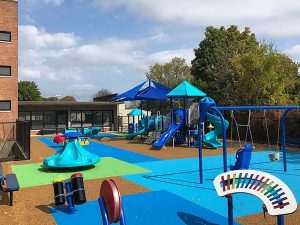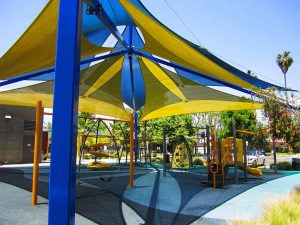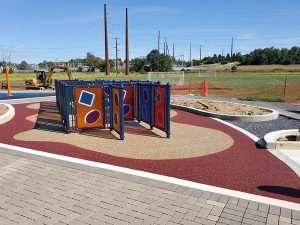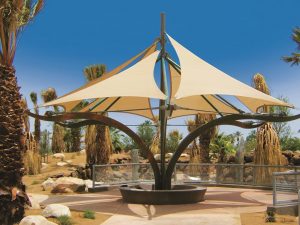Planning/Getting Started
Webber Rec’s complete guide to planning your playground
Building a playground is a big undertaking. If you need help navigating your project, check out Webber Rec’s guide to playground planning!
Getting started ↓
Analyzing your site and your needs ↓
Fundraising for your playground ↓
Choosing equipment for your playground ↓
Preparing your site for installation ↓
Installing your playground ↓
Maintaining your playground ↓
 Getting started
Getting started
Step one is outlining your goals and determining whether you’ll face any city or school restrictions. Start by asking yourself these five questions:
- Who will use this playground?
You need to know who your playground is intended for. Specifically, you need to consider:- Age. Children play differently at different ages. Equipment designed for preschoolers won’t be fun for middle schoolers. (Plus, it won’t be the right size!) At the same time, more advanced and challenging equipment isn’t the right fit for younger kids.
- Ability. As of 2011, all public playground facilities must also comply with the guidelines set forth under the 2010 Standards for Accessible Design.
- Number. How many kids will use the equipment at any time? You need to know so you can plan accordingly.
- How much space do you have?
Consider the space allotted for your playground at your school, daycare, or town. Do you have room for multiple play spaces, or just a small one?Also remember that the playground area extends beyond the equipment. You’ll need cushioned safety surfacing that extends at least six feet beyond the edge of your structures. For slides and swings, an even larger area is recommended. - Are you starting new or adding on to an existing playground?
Is your playground totally new, a renovation of old equipment, or an addition? There are special considerations for each case, like analyzing the space you have and the limitations of any existing equipment. - What is your timeline?
When is the best time to open your playground? Planning in late summer or early fall might make sense if you want your new playground open by spring. For a school playground, planning in the early spring would give you enough time to by ready at the start of the next academic year. - What is your budget?
Consider what your budget will and will not allow you to do, as well as where your money will come from and whether you need to fundraise.If you have a defined budget, tailor your plans to that amount. If you plan to fundraise, create a budget based on your playground’s size and the type of equipment you want. From there, set a fundraising goal.Keep a big-picture perspective when putting together your budget. The play structure itself is only one of many things you need to account for.
Things to consider when planning a playground budget:
- Permits
- Site preparation
- Ancillary equipment and features (examples: lighting or sidewalks)
- Surfacing equipment
- Play equipment and playground surfacing (including shipping)
- Storing any materials or tools off-site
- Installing the equipment and surfacing
Analyzing your site and your needs
Your playground’s location will impact every stage of its construction. Here are some key things to look at when analyzing your site:
- Slope. The shape of your location’s surface determines whether water will pool (and create a muddy mess) or drain away easily. If your location is prone to puddles, you may have to do some prep work to create better drainage patterns.
- Soil type. Soil type impacts both drainage and ground stability. For example, sandy soils don’t hold water well, which is great for drainage, but its looseness can mean less stability. Again, you may have some additional work to do depending on the soil in your area.
- Vegetation. Shade trees are an asset to your playground, so you need to find out where their roots are located and whether digging in the area will harm them. Also consider the quality and type of other plants in the area. Be careful of pesticides and consider whether nearby vegetation will attract insects or rodents. If you’re going to add plants or landscaping, choose drought-resistant native varieties that require little maintenance.
- Weather. Study the weather around the playground site throughout the day. Take note of particularly sunny or hot spots and whether there is excessive wind.
- Utility lines. Contact local utility companies and confirm there are no lines or cables running under your site.
- Local amenities. A playground near public restrooms, picnic tables, or parking lots is going to be appealing and easy to access. For safety, consider how close the playground will be to major roads or highways and whether you need any fencing or barriers.
Fundraising for your playground
Fundraising can take many forms. For your project, maybe it makes sense to ask school parents to donate. Or maybe it’s a better fit to organize individual fundraising events, like bake sales and car washes.
Grants are another funding option and there are many options, including grants from:
- Local, state, or federal governments
- Large businesses
- Non-profit organizations
Competition for grants is fierce, so the sooner you start looking the better. Take time to create a stand-out application.
You could also consider leasing equipment and making monthly payments instead of purchasing it outright. Leasing can eliminate the need for intensive fundraising and help you manage cash flow. You will also be eligible for tax deductions over several years if you lease.
Choosing equipment for your playground
When you’re picking equipment, think about the kids who will be using it. If you’re not sure what they’ll want to use, ask them! Hold a focus group with kids and parents or ask them to submit a design of their dream playground.
Types of playground equipment
- Structural equipment. The equipment that makes up the bones of a playground. It can include slides, towers, ramps, decks, bridges, etc.
- Freestanding equipment. Any equipment that’s not attached to the primary structure. Popular examples are freestanding swings and slides, spring rockers, climbers, and accessories.
- Fitness equipment. Structures that encourage kids (and adults) to exercise while playing.
- Site furnishings. Structures that improve the playground experience. Includes bike racks, benches, trash bins, etc.
- Inclusive equipment. Structures that make a playground inclusive and accessible to children of all abilities. Examples include buddy rockers and roller slides.
- Structures that offer shade to keep the playground comfortable.
Developing playground equipment plans
After choosing your equipment, you need to figure out how to put it together in a way that makes sense for your needs and your budget. A playground design expert—like the Webber Rec—can help, especially with the following:
- Type of materials to use. The type of material best for your playground will depend on where you live and your climate.
- Style of the playground. Should your playground be bright and eye-catching or natural-looking? Will it have a distinct theme? Our playground design team can help you answer these questions.
- Number and layout of components. Now that you’ve chosen your equipment, you need to finalize how it will fit together and how to arrange it. For example, you might want to group equipment by age group or difficulty level.
Preparing your site for installation
How much preparation your site needs before the equipment can be installed depends on its condition. If there’s already playground equipment on site, you’ll need to remove it if you’re completely redoing the space. You might be able to donate it to another organization, if it’s in good condition and meets safety requirements. Otherwise, recycle it or sell it as scrap.
As noted above, you may need to level the site or improve the soil to fix any drainage issues or make the ground more stable. This is also the time to call the utility companies and have them mark any underground lines.
Installing your playground
You have a two main options for installing the playground:
- Hire a team of professionals and have them install the surfacing and equipment.
- Host a community build, where a team of volunteers handles the heavy lifting and installation under the supervision of a professional. Beyond saving cost, community builds help people feel more invested in the playground. They also help organizations or local governments bond with members of the community they serve.
Maintaining your playground
The project isn’t done when the playground is installed—you must know how to maintain it, so it lasts for many years. That means following recommendations for care and repairs. Equipment should also be inspected regularly by a certified professional to reduce the risk of accidents.
Organize regular events to care for the playground and the park around it. For example, you could have cleanup days, when members of the community work together to pick up litter, clean the equipment, and take care of any trees or landscaping. These events will help people continue to feel connected to the playground you’ve built.
Our affiliates
Need help funding your playground or planning a community build day? Wondering about certified playground inspection?
Webber Rec is proud to be affiliated with the following organizations, which offer many helpful resources.
- Sourcewell – Sourcewell offers resources, including cooperative purchasing, to educational and government entities in Central Minnesota. Visit sourcewell-mn.gov to learn more.
- Minnesota Recreation & Park Association –MRPA offers networking opportunities and educational events on topics like certified playground safety inspection. Visit mnrpa.org to learn more.
- Minnesota Educational Facility Management Professionals – Also called MASMS. Members learn about safely operating and maintaining recreational areas. Visit masms.org to learn more.
- Minnesota Elementary School Principals’ Association – MESPA provides many professional resources, including information on grants. Visit mespa.net to learn more.
- Minnesota School Boards Association – MSBA offers a range of training, advocacy, and networking opportunities. Visit mnmsba.org to learn more.
- National Recreation & Park Association –NRPA connects communities to grant opportunities, certification courses, and more. Visit nrpa.org to learn more.
- Kaboom! – Kaboom is a nonprofit that helps communities plan playgrounds, organize community builds, and find grant opportunities. Visit kaboom.org to learn more.
 Getting started
Getting started

